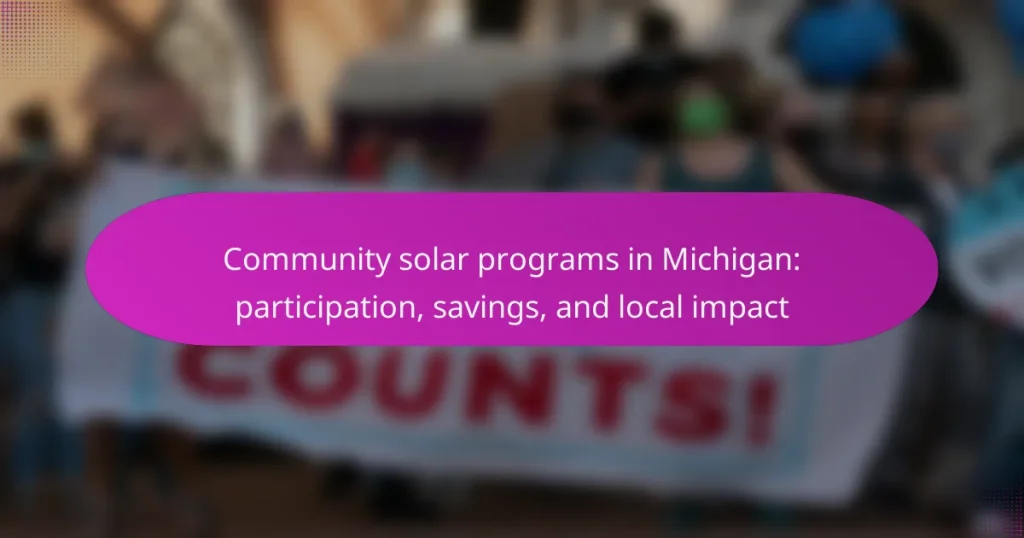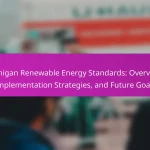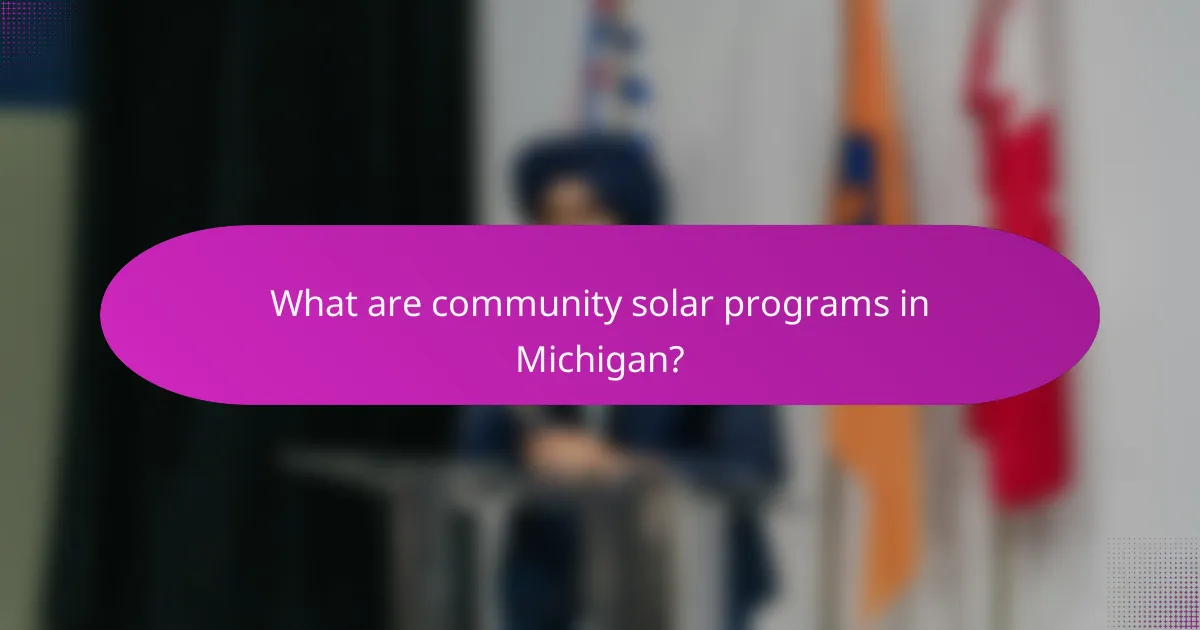
What are community solar programs in Michigan?
Community solar programs in Michigan are initiatives that allow multiple participants to invest in or benefit from a shared solar energy system. These programs enable residents, businesses, and organizations to access solar power without needing to install individual solar panels. Participants receive credits on their utility bills based on their share of the energy produced by the community solar project. As of 2023, Michigan has several community solar projects, with the capacity to generate significant renewable energy. These initiatives promote energy equity and sustainability, making solar energy accessible to those who may not have suitable rooftops or the financial means for individual solar installations.
How do community solar programs operate?
Community solar programs operate by allowing multiple participants to invest in a shared solar energy system. These systems are typically installed in a centralized location, such as a solar farm. Participants can subscribe to a portion of the energy produced by the system. They receive credits on their utility bills based on their share of the solar energy generated. This model provides access to solar energy for those who cannot install solar panels on their properties. Community solar programs also promote renewable energy adoption and can reduce overall energy costs for participants. In Michigan, these programs are regulated to ensure fair access and benefits for all participants.
What are the key components of community solar programs?
Community solar programs consist of several key components. They include shared solar facilities, which allow multiple participants to benefit from a single solar installation. Participants typically subscribe to a portion of the energy produced by the solar array. This arrangement allows individuals who cannot install solar panels on their property to access solar energy.
Financing options are also crucial, often involving upfront costs or subscription fees. Incentives, such as tax credits or rebates, can enhance participation by making solar energy more affordable. Additionally, community engagement is vital for raising awareness and encouraging local involvement.
Regulatory frameworks govern these programs, ensuring compliance with state laws and utility regulations. Together, these components create an accessible and sustainable model for solar energy in communities.
How do participants benefit from these programs?
Participants benefit from community solar programs in Michigan through cost savings and increased access to renewable energy. These programs allow individuals to invest in solar energy without the need for personal solar panel installation. Participants typically receive credits on their electricity bills, resulting in reduced energy costs. A study by the National Renewable Energy Laboratory found that community solar can lower electricity expenses by up to 10%. Additionally, these programs enhance energy resilience and promote environmental sustainability. By participating, individuals contribute to local green energy initiatives, fostering community engagement and support for renewable resources.
Why are community solar programs important for Michigan residents?
Community solar programs are important for Michigan residents because they provide access to renewable energy without the need for individual solar installations. These programs allow residents to participate in solar energy generation collectively. This collective approach increases energy savings for participants. According to the Michigan Public Service Commission, community solar can reduce electricity costs for subscribers by up to 20%. Additionally, these programs promote local job creation in the renewable energy sector. They also contribute to the state’s environmental goals by increasing the share of clean energy sources. Community solar initiatives foster energy independence and resilience for Michigan communities.
What environmental benefits do these programs provide?
Community solar programs in Michigan provide significant environmental benefits. They promote the use of renewable energy sources, reducing reliance on fossil fuels. This shift helps decrease greenhouse gas emissions, which contribute to climate change. Studies indicate that renewable energy can lower carbon emissions by up to 70%. These programs also enhance local biodiversity by preserving green spaces. By utilizing land for solar energy, they can prevent urban sprawl and habitat destruction. Additionally, community solar projects often incorporate sustainable practices, improving soil health and water quality. Overall, these initiatives contribute positively to the local ecosystem and promote a cleaner environment.
How do community solar programs contribute to energy equity?
Community solar programs contribute to energy equity by providing access to renewable energy for underserved populations. These programs allow individuals who cannot install solar panels, such as renters or low-income households, to benefit from solar energy. By participating in community solar, these individuals can reduce their energy costs and reliance on fossil fuels. According to a report by the National Renewable Energy Laboratory, community solar projects can increase access to clean energy for 50 million people in the U.S. This inclusivity helps to address energy disparities and promotes environmental justice. Furthermore, community solar programs can stimulate local economies by creating jobs in installation and maintenance.
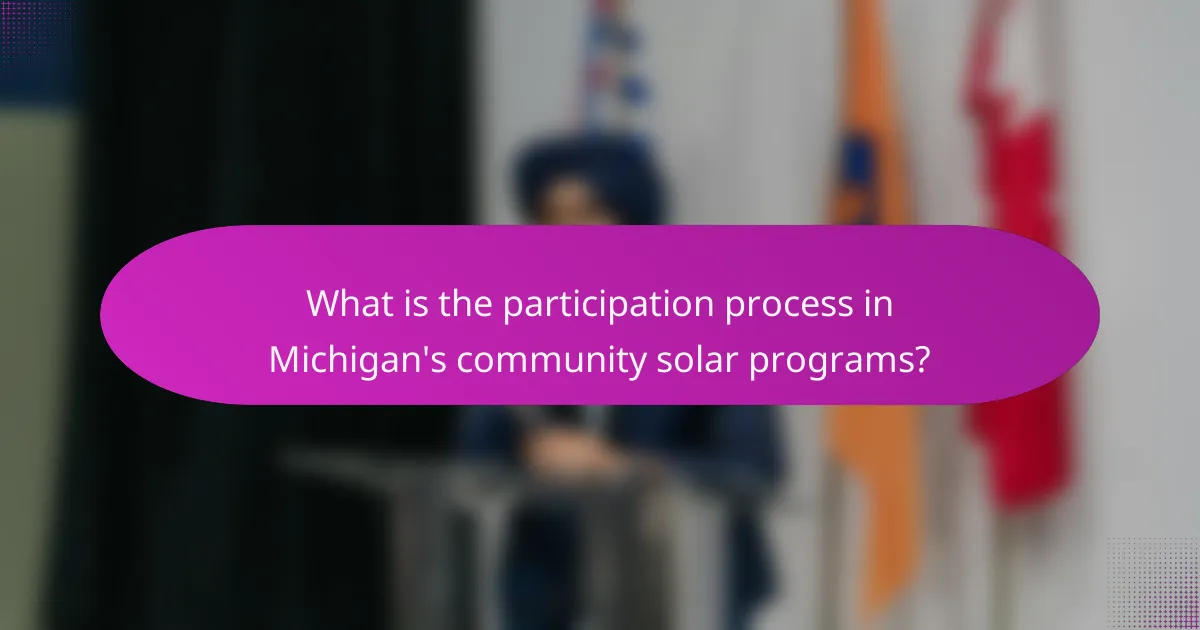
What is the participation process in Michigan’s community solar programs?
The participation process in Michigan’s community solar programs involves several key steps. First, interested individuals must identify available community solar projects in their area. They can typically find this information through local utility companies or solar developers. Next, participants need to sign a subscription agreement with the chosen solar project. This agreement outlines the terms, including the amount of energy they will receive and the associated costs.
Once the agreement is signed, participants may need to pay an upfront fee or agree to monthly payments. After this, the solar energy generated by the community project is allocated to the participants’ utility accounts. Participants will receive credits on their utility bills based on the amount of energy produced by the solar project. This process allows residents to benefit from solar energy without needing to install panels on their own properties.
According to the Michigan Public Service Commission, community solar programs are designed to increase access to renewable energy for those who may not have suitable roofs for solar panels.
How can individuals sign up for community solar programs?
Individuals can sign up for community solar programs by contacting local solar providers or utilities offering such programs. They typically need to provide basic personal information and may have to fill out an enrollment form. Some programs allow online sign-ups through their websites. Others may require individuals to visit local offices or attend informational sessions. Participants usually need to confirm their eligibility based on location and utility service. After signing up, individuals can expect to receive details about their subscription and any associated costs. Community solar programs often aim to make solar energy accessible to those who cannot install solar panels on their property.
What eligibility criteria must be met to participate?
Eligibility criteria for community solar programs in Michigan typically include being a resident of the state. Participants must also have an active utility account with a participating utility provider. Additionally, individuals may need to meet certain income requirements, which can vary by program. Some programs may prioritize low-income households or specific demographics. Proof of residency and utility account details are often required for enrollment. These criteria ensure that participants benefit from the program while supporting local energy initiatives.
What types of commitments are required from participants?
Participants in community solar programs in Michigan are required to make several commitments. These typically include a financial commitment to purchase shares or subscriptions in the solar project. Participants may also need to commit to a minimum contract duration, often ranging from 10 to 25 years.
Additionally, participants must agree to the terms and conditions set by the solar provider, which may involve maintenance and operational responsibilities. Active participation in community meetings may also be encouraged to foster engagement and feedback.
These commitments ensure the sustainability and success of the solar initiative, allowing for shared benefits among all participants.
What are the common misconceptions about participation?
Common misconceptions about participation in community solar programs include the belief that only homeowners can participate. In reality, renters and those without suitable roofs can also join. Another misconception is that participation requires a significant financial investment. Many programs offer low or no upfront costs. Some individuals think that participation is limited to large energy users. However, community solar is designed to accommodate all energy consumers, regardless of usage size. Additionally, some believe that participating means losing control over their energy choices. Participants typically retain the ability to choose their energy supplier. These misconceptions can lead to confusion and deter potential participants from benefiting from community solar programs.
How does participation differ from traditional solar ownership?
Participation in community solar programs differs from traditional solar ownership in that it allows individuals to invest in a shared solar project rather than installing solar panels on their property. In traditional solar ownership, homeowners are responsible for the installation, maintenance, and costs associated with their solar systems. Community solar participants, however, can benefit from solar energy without the need for physical installation on their property. This model often requires less upfront investment and provides access to renewable energy for those who may not have suitable rooftops for solar panels. Additionally, participants typically receive credits on their utility bills based on their share of the solar energy produced. This structure promotes broader access to renewable energy, making it feasible for renters and those with financial limitations to engage in solar energy use.
What are the potential risks of joining a community solar program?
Joining a community solar program can involve several potential risks. One risk is financial instability. Participants may face unexpected fees or costs that can negate savings. Another risk is the variability of energy production. Solar energy generation can fluctuate due to weather conditions, impacting the expected energy credits. Furthermore, the contractual obligations can be complex. Participants might find themselves locked into long-term agreements with limited flexibility. There is also the risk of project viability. If the solar installation fails or is underperforming, participants may not receive anticipated benefits. Additionally, regulatory changes can affect community solar programs. Changes in state policies may alter incentives or participation terms. Lastly, participants may experience limited control over the energy source. This could lead to dissatisfaction if the solar farm does not meet expectations.
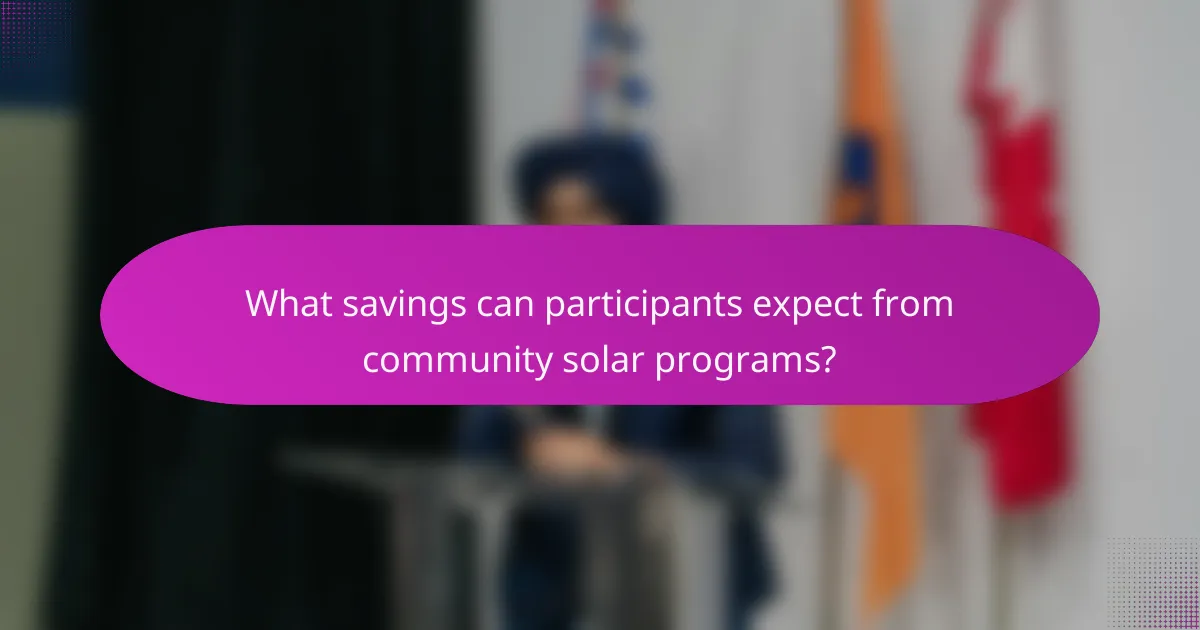
What savings can participants expect from community solar programs?
Participants in community solar programs can expect savings of 10% to 30% on their electricity bills. These savings vary based on the program and local utility rates. Community solar allows participants to share the benefits of solar energy without installing panels on their property. In Michigan, the average participant sees a reduction in monthly energy costs. This is often due to lower rates associated with community solar subscriptions. Additionally, these programs can provide credits for excess energy generated. Participants benefit from predictable energy pricing, which can shield them from rising utility costs.
How are savings calculated for participants?
Savings for participants in community solar programs are calculated based on the amount of energy they consume and the credits they receive from the solar energy produced. Participants typically receive a share of the total energy generated by the solar array. This share is determined by their investment or subscription size.
The energy credits are applied to their utility bills, reducing their overall costs. The calculation also considers the local utility’s rate structure and any applicable incentives. For example, Michigan utilities may offer specific credits per kilowatt-hour generated by community solar projects.
These calculations ensure that participants benefit from the renewable energy produced, leading to potential savings on their electricity bills. The savings can vary based on energy consumption and the performance of the solar installation.
What factors influence the amount of savings?
The amount of savings in community solar programs is influenced by several factors. Key factors include the size of the solar array, local electricity rates, and program participation fees. Larger solar arrays typically produce more energy, leading to higher savings. Local electricity rates determine the value of the energy produced. Higher rates can result in greater savings for participants. Additionally, participation fees can reduce overall savings. Other factors include state incentives, the availability of tax credits, and the length of the contract. These elements collectively shape the financial benefits of community solar programs.
How do savings compare to traditional energy sources?
Savings from community solar programs typically exceed those from traditional energy sources. Community solar often provides lower rates than conventional utility prices. Participants can save an average of 10% to 30% on their energy bills. Traditional energy sources, such as fossil fuels, often have fluctuating prices due to market volatility. In contrast, community solar offers predictable savings through fixed-rate contracts. Additionally, community solar projects contribute to local economies and promote sustainable energy practices. This dual benefit enhances the financial advantages of participating in such programs compared to relying solely on traditional energy sources.
What impact do community solar programs have on local economies?
Community solar programs positively impact local economies by creating jobs and generating local revenue. These programs typically require installation and maintenance, leading to employment opportunities in the renewable energy sector. According to a report by the National Renewable Energy Laboratory, community solar projects can create approximately 1.5 jobs per megawatt installed. Additionally, they contribute to local tax revenues, which can fund public services. Community solar also lowers energy costs for participants, allowing them to allocate savings to other local businesses. This increased economic activity can stimulate growth in surrounding areas. Overall, community solar programs foster sustainable economic development within local communities.
How do these programs create jobs in Michigan?
Community solar programs in Michigan create jobs by stimulating local economies through renewable energy projects. These programs require installation, maintenance, and management of solar panels, generating demand for skilled labor. The Michigan Solar Jobs Report indicates that the solar industry has created over 5,000 jobs in the state. Additionally, community solar initiatives attract investment, further boosting job creation in related sectors. Local contractors and suppliers benefit from increased business opportunities, enhancing the overall job market.
What are the long-term economic benefits for communities?
Community solar programs provide long-term economic benefits for communities. These programs reduce energy costs for participants, leading to increased disposable income. They also create local jobs in installation and maintenance, stimulating the local economy. Additionally, community solar projects increase property values by enhancing energy accessibility. According to a report from the National Renewable Energy Laboratory, community solar can lead to a 10% reduction in energy bills for participants. This savings can be reinvested into local businesses, further boosting economic growth. Furthermore, these programs can attract new residents and businesses seeking sustainable energy options, fostering community development.
What tips can participants follow to maximize their benefits?
Participants in community solar programs can maximize their benefits by understanding their energy usage. They should assess their monthly energy consumption to select the right subscription level. Engaging with program coordinators can provide insights into potential savings. Participants should also stay informed about program updates and incentives. Regularly reviewing their energy bills helps track savings effectively. Additionally, they can encourage neighbors to join, increasing community impact. Lastly, utilizing available resources, such as workshops or informational sessions, enhances overall understanding and participation.
Community solar programs in Michigan enable residents, businesses, and organizations to invest in shared solar energy systems, providing access to renewable energy without individual installations. Participants receive utility bill credits based on their share of energy produced, promoting energy equity and sustainability. The article outlines the operation, benefits, and participation process of these programs, including financial savings, environmental impact, and local economic growth. Key components such as financing options, regulatory frameworks, and community engagement are discussed, highlighting the importance of these initiatives for Michigan’s energy landscape.
